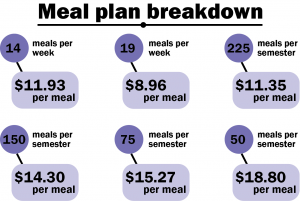Once the hustle and bustle of the noon lunch rush reaches Upper Cort, it’s difficult to avoid lines if students want something made specifically for them. The other option is ordering pre-packaged food, which is often pricier than when sold at local grocery stores.
An example is the Oreos priced at over $8 a pack and valued at two meal swipes. The cash equivalency rate of meal swipes set by dining services is $3.50 during breakfast, or until 10:30 a.m., and $4.50 for the remainder of the day.
If the meal swipe cash equivalency were priced fairly, any meal plan would use only one swipe to buy them. And you’d still have money left over to reach the capacity of the swipe.
Depending on your meal plan, however, each swipe has a different cost. If you split the whole cost of your meal plan equally between each swipe — after subtracting the amount of dining dollars — they should cost between $8.96 and $16.80.
That’s nearly double, or sometimes more than three times, the cash amount the dining halls have set.
So really, when you use two meal swipes to pay for those $8 Oreos, you’re not actually spending the $9 your two swipes equate. Depending on your meal plan, you could be wasting two swipes with much greater values.
Although meal swipes are supposed to be used primarily for buffet-style dining halls — which charge from $7.25 to $13.75 at the door if you don’t have a meal plan — the meal swipe value is even unfair for some of these prices as well.
The best meal swipe value is in the 19-meals-per-week plan, which comes up to $8.96 per meal. In that case, there’s only one time of day in which it’s more expensive to get in with your meal plan — breakfast.
For the three priciest plans — 150 meals per semester, which comes to $14.30 per meal swipe; 75 meals per semester, which is $15.27 per meal swipe; and 50 meals per semester, which is $16.80 per meal — these door prices are unfair, since students or their parents are paying more for the value.
First-year students, and some sophomores, are required to have a meal plan, but is that really cost effective?
Students could easily walk to some of the South Side businesses that have similar meals cheaper or around the same value as those offered by on-campus dining halls. Not only that, but Upper Cort products are overpriced when compared to those same products when sold in a supermarket.
As for dining dollars plans, you pay a dollar to dollar equivalent with the food at Upper Cort, but their overpriced products still make it more cost effective to buy food from somewhere else.
The system is not only not cost effective, but also wasteful. You get a better monetary deal on plans with more meals than plans with less meals. But, most students don’t use up all their meal swipes in these big meal plans — that’s why the end of the year bulk sales are so popular.
There has to be a better way to divvy up the cash equivalence so students’ meal plans are more cost effective. Because even when you account for service and materials, the prices shouldn’t be so high.





Comment policy
Comments posted to The Brown and White website are reviewed by a moderator before being approved. Incendiary speech or harassing language, including comments targeted at individuals, may be deemed unacceptable and not published. Spam and other soliciting will also be declined.
The Brown and White also reserves the right to not publish entirely anonymous comments.